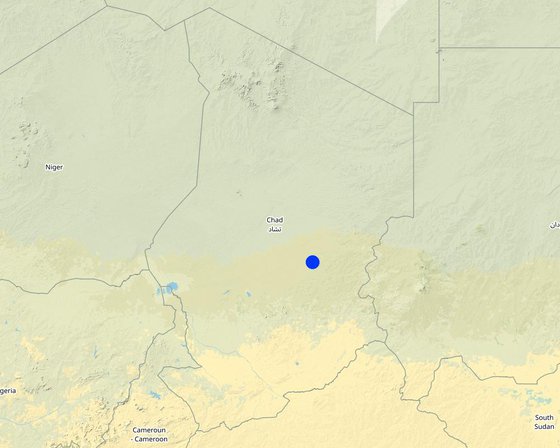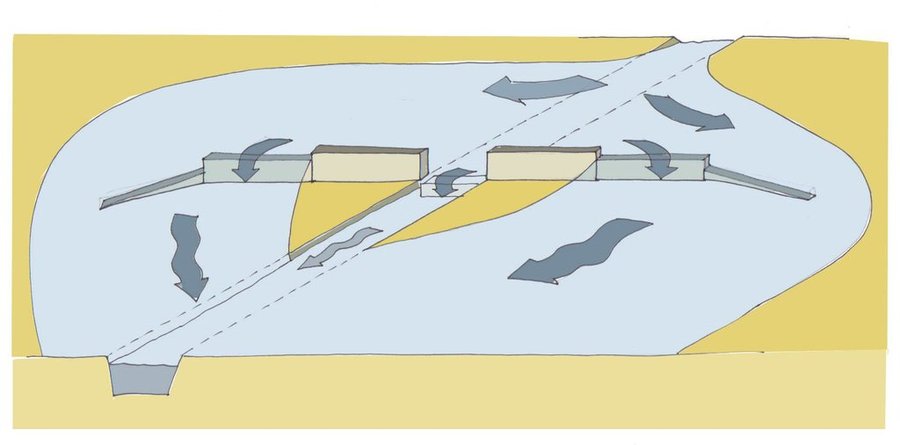

Over the last 12 years water-spreading weirs have been introduced and improved as a new rehabilitation technique for degraded dry valleys in Burkina Faso, Niger and Chad. In Chad 104 water-spreading weirs were constructed in the scope of the two development projects, initiated by the German Technical Cooperation (GIZ) and the Swiss Development Cooperation (SDC) in the 1990s. Water-spreading weirs are made of natural stones and cement, and consist of a spillway in the actual riverbed and lateral abutments and wings. Floodwaters are spread over the adjacent land area above the structure, where they eventually overflow the lateral wings and then slowly flow back towards the riverbed below the structure. As a result the land area below the weir is flooded. The lateral spreading of the water causes the land area above and below the structure to be flooded and supplies it with sediment. Water infiltrates, gullies in the valley are filled and the riverbed is raised. Thanks to the infiltration, the groundwater table also rises in a few years.
Purpose of the Technology: In dry valleys in which water flows in the rivers for only a few days a year, the weirs serve to distribute the incoming runoff over the valley floor and allow as much water as possible to infiltrate the soil. The aquifer is thus replenished and is then available for agricultural use. In contrast to the various types of dams, the goal of water-spreading weirs is not to create reservoirs for later use. What water-spreading weirs do is cause a temporary flooding of the adjacent land area above and below the weir. Depending on user preferences, the primary goal may be 1) agricultural use, 2) sylvo-pastoral use or 3) the replenishment and rising of the water table.
Establishment / maintenance activities and inputs: Water-spreading weirs require detailed technical planning and experienced engineering and construction firms. The bulk of the work is performed using local materials and by village craftsmen and helpers.
Natural / human environment: Compared to small impoundment dams, retention basins and microweirs, water-spreading weirs are especially well-suited for shallow, wide valleys that, due to severe gully erosion, are no longer inundated by small and medium
volume floodwaters. The flooding no longer takes place because the actual riverbed has been deeply eroded and enlarged. However, water-spreading weirs are also suitable for improving agricultural productivity in more or less intact valley floors. Water-spreading weirs are successful in regions where precipitation during the growing season is erratic and where the weirs ensure a more evenly distributed water supply for crops, as well as in zones in which water enrichment makes one or two additional growing seasons possible. At the present time they are in use in a broad area where annual rainfall ranges from 50 to 1,200 mm/year.

ទីតាំង: Eastern Chad, ប្រទេសឆាដ
ចំនួនទីកន្លែងបច្ចេកទេស ដែលវិភាគ:
ការសាយភាយនៃបច្ចេកទេស: ត្រូវបានផ្សព្វផ្សាយត្រឹមតំបន់មួយ (approx. 10-100 គម2)
តើស្ថិតក្នុងតំបន់ការពារអចិន្ត្រៃយ៍?:
កាលបរិច្ឆេទនៃការអនុវត្ត: 10-50 ឆ្នាំ
ប្រភេទនៃការណែនាំឱ្យអនុវត្តន៍៖






| បញ្ជាក់ពីធាតុចូល | ឯកតា | បរិមាណ | ថ្លៃដើមក្នុងមួយឯកតា (មិនមាន) | ថ្លៃធាតុចូលសរុប (មិនមាន) | % នៃថ្លៃដើមដែលចំណាយដោយអ្នកប្រើប្រាស់ដី |
| កម្លាំងពលកម្ម | |||||
| Labour | ha | 1,0 | 750,0 | 750,0 | 100,0 |
| សម្ភារៈ | |||||
| Total costs for equipment | ha | 1,0 | 750,0 | 750,0 | |
| សម្ភារៈសាងសង់ | |||||
| Stone | ha | 1,0 | 750,0 | 750,0 | |
| ថ្លៃដើមសរុបក្នុងការបង្កើតបច្ចេកទេស | 2'250.0 | ||||
| បញ្ជាក់ពីធាតុចូល | ឯកតា | បរិមាណ | ថ្លៃដើមក្នុងមួយឯកតា (មិនមាន) | ថ្លៃធាតុចូលសរុប (មិនមាន) | % នៃថ្លៃដើមដែលចំណាយដោយអ្នកប្រើប្រាស់ដី |
| កម្លាំងពលកម្ម | |||||
| Labour | ha | 1,0 | 50,0 | 50,0 | 100,0 |
| សម្ភារៈ | |||||
| Total costs for equipment | ha | 1,0 | 50,0 | 50,0 | |
| សម្ភារៈសាងសង់ | |||||
| Stone | ha | 1,0 | 50,0 | 50,0 | |
| ថ្លៃដើមសរុបសម្រាប់ការថែទាំដំណាំតាមបច្ចេកទេស | 150.0 | ||||
គុណភាពមុន SLM: 158 kg/ha
គុណភាពក្រោយ SLM: 653 kg/ha
Increase of millet yield in Chad
គុណភាពមុន SLM: 6,000 cattle head
គុណភាពក្រោយ SLM: 16,000 cattle heads
The increase in groundwater level has led to a significant increase in the number of cattle heads that can be watered
គុណភាពមុន SLM: 2.85 ha
គុណភាពក្រោយ SLM: 5.29 ha
The numbers are from a study on water-spreading weirs in Niger, but for Chad the situation is comparable
Users of water-spreading weirs had 112% higher incomes compared to farmers outside the impact zone from sales of vegetables and surplus grain
The workload of women is eased thanks to the availability of and easier access to water due to the shallower water table
Temporary income was generated for the local workers during the weir construction. About 231 Euros per user family.
Food security assured through crop and livestock farming
Children have a healthier, more diverse diet due to the vegetable production and the introduction of new crops
The weirs are becoming an element of interaction and social integration for the inhabitants of surrounding villages
Through training
Decline in conflicts between farmers and livestock raisers over water rights owing to the fact that sufficient water is now available
Temporary emigration to Sudan and Lybia has declined and in some villages people who had long since emigrated returned home
In the vicinity of the weirs activities such as trading of agricultural products, fishing, watering livestock and making clay tiles have emerged
Numerous local masons were trained
Village people, service providers, communal representatives, government technical sectors have improved their skills in organisation, planning and implementation
More and longer-lasting bodies of surface water
In some communities groundwater has risen to a depth of 6m below surface
Gullies are filled in
Deposition of nutrients
Deposition of organic matter
Spread of natural vegetation around the rehabilitated valley plains
Vanished plant species return
Vanished animal species return